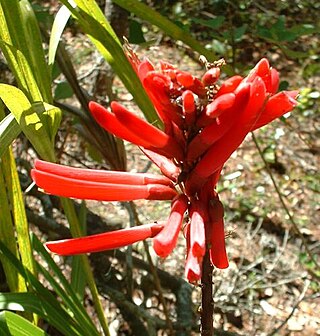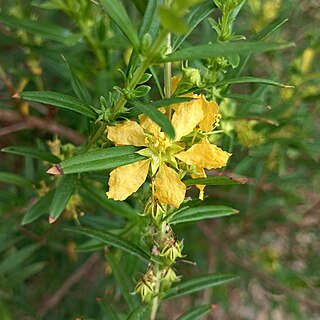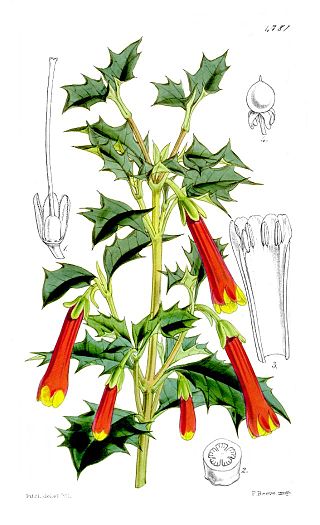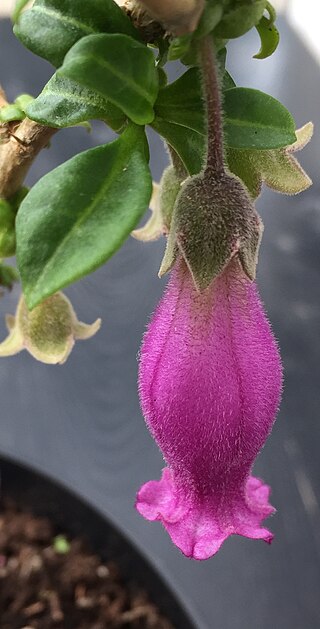
Datura is a genus of nine species of highly poisonous, vespertine-flowering plants belonging to the nightshade family (Solanaceae). They are commonly known as thornapples or jimsonweeds, but are also known as devil's trumpets. Other English common names include moonflower, devil's weed, and hell's bells. All species of Datura are extremely poisonous and psychoactive, especially their seeds and flowers, which can cause respiratory depression, arrhythmias, fever, delirium, hallucinations, anticholinergic syndrome, psychosis, and death if taken internally.

Apocynaceae is a family of flowering plants that includes trees, shrubs, herbs, stem succulents, and vines, commonly known as the dogbane family, because some taxa were used as dog poison. Members of the family are native to the European, Asian, African, Australian, and American tropics or subtropics, with some temperate members. The former family Asclepiadaceae is considered a subfamily of Apocynaceae and contains 348 genera. A list of Apocynaceae genera may be found here.

Erythrina is a genus of plants in the pea family, Fabaceae. It contains about 130 species, which are distributed in tropical and subtropical regions worldwide. They are trees, with the larger species growing up to 30 m (98 ft) in height. The generic name is derived from the Greek word ερυθρóς erythros, meaning "red", referring to the flower color of certain species.

Hypericum calycinum is a species of prostrate or low-growing shrub in the flowering plant family Hypericaceae. Widely cultivated for its large yellow flowers, its names as a garden plant include rose-of-Sharon in Britain and Australia, and Aaron's beard, great St-John's wort, creeping St. John's wort and Jerusalem star. Grown in Mediterranean climates, widely spread in the Strandzha Mountains along the Bulgarian and Turkish Black Sea coast.

Erythrina herbacea, commonly known as the coral bean, Cherokee bean, Mamou plant in South Louisiana, red cardinal or cardinal spear, is a flowering shrub or small tree found throughout the southeastern United States and northeastern Mexico; it has also been reported from parts of Central America and, as an introduced species, from Pakistan. Various other systematic names have been used for this plant in the past, including Erythrina arborea, Erythrina hederifolia, Erythrina humilis, Erythrina rubicunda, Corallodendron herbaceum and Xyphanthus hederifolius.

Argyreia nervosa is a perennial climbing vine native to the Indian subcontinent and introduced to numerous areas worldwide, including Hawaii, Africa, and the Caribbean. Though it can be invasive, it is often prized for its aesthetic and medicinal value. Common names include Hawaiian baby woodrose, adhoguda अधोगुडा or vidhara विधारा (Sanskrit), elephant creeper and woolly morning glory. Its seeds are known for their powerful entheogenic properties, greater or similar to those of Ipomoea species, with users reporting significant psychedelic and spiritual experiences. The two botanical varieties are A. n. var. nervosa described here, and A. n. var. speciosa, which are used in Ayurvedic medicine for their medicinal value.

Brugmansia is a genus of seven species of flowering plants in the nightshade family Solanaceae. They are woody trees or shrubs, with pendulous flowers, and have no spines on their fruit. Their large, fragrant flowers give them their common name of angel's trumpets, adjacent to the nickname devil's trumpets of the closely related genus Datura.

Cryogenine, also known as vertine or (10α)-4,5-dimethoxy-2-hydroxylythran-12-one, is a biphenylquinolizidine lactone alkaloid from the plants Sinicuichi and H. myrtifolia. The compound has no psychoactive properties in humans up to 310 mg, but has shown anti-inflammatory activity similar to aspirin.

Heimia salicifolia is a species of flowering plant in the Loosestrife family, Lythraceae. It is native to the Americas, ranging from the southwestern United States through Mexico and Central America to Argentina. Common names include shrubby yellowcrest, sinicuichi, sun opener, willow-leaf heimia, sini. The plant has been used for shamanic purposes by native peoples in Central America and Mexico.

Spartium junceum, known as Spanish broom, rush broom, or weaver's broom, it is a species of flowering plant in the family Fabaceae and the sole species in the genus Spartium. It is closely related to the other brooms.

The ancient Aztecs employed a variety of entheogenic plants and animals within their society. The various species have been identified through their depiction on murals, vases, and other objects.

Desfontainia is a genus of flowering plants in the family Columelliaceae, though it was placed formerly in Loganiaceae, Potaliaceae, or a family of its own, Desfontainiaceae.

Voacanga africana is a small tree native to tropical Africa belonging to the family Apocynaceae that grows to 6 m (20 ft) in height and bears leaves that are up to 30 cm (12 in) in length. The yellow or white flowers are succeeded by paired, follicular, dehiscent fruit with a mottled green exocarp and a pulpy, yellow mesocarp surrounding the seeds. The plant contains alkaloids acting as CNS depressants and hypotensives

Senegalia berlandieri is a shrub native to the Southwestern United States and northeast Mexico that belongs to the Mimosoid clade of Fabaceae. It grows 1 to 5 metres tall, with blossoms that are spherical and white, occurring from February through April. The berlandieri epithet comes from the name of Jean-Louis Berlandier, a French naturalist who studied wildlife native to Texas and Mexico. S. berlandieri contains a wide variety of alkaloids and has been known to cause toxic reactions in domestic animals such as goats.

Latua pubiflora(Griseb.) Baillon, is the single species of the monotypic genus LatuaPhil., endemic to the coastal mountains of southern Chile. A shrub or small tree to 10 m in height, bearing attractive, magenta-to-red, hummingbird-pollinated flowers, it is extremely poisonous – hallucinogenic (deliriant) in smaller doses – due to tropane alkaloid content and is used by Chilean machi (shamans) of the Mapuche–Huilliche people in traditional medicine, as a poison and to enter trance states. Its elegant flowers and yellow tomato-like fruit are attractive enough to merit cultivation as an ornamental.
Viktor Aloisius Reko, was an Austrian teacher and scientific author who moved to Mexico in 1921. He is best known for his popular book Magische Gifte: Rausch- und Betäubungsmittel der Neuen Welt, first published in 1936. This book recorded a number of second-hand observations on New World psychoactive drugs, paraphrased from notes he took of conversations with his cousin, the eminent Mexican ethnobotanist Dr. Blas Pablo Reko, including the first published refutation of Dr. William Edwin Safford's uncharacteristically untenable assertion that teonanácatl was not a mushroom, but a cactus.

The peyote is a small, spineless cactus which contains psychoactive alkaloids, particularly mescaline. Peyote is a Spanish word derived from the Nahuatl peyōtl, meaning "caterpillar cocoon", from a root peyōni, "to glisten". Peyote is native to Mexico and southwestern Texas. It is found primarily in the Sierra Madre Occidental, the Chihuahuan Desert and in the states of Nayarit, Coahuila, Nuevo León, Tamaulipas, and San Luis Potosí among scrub. It flowers from March to May, and sometimes as late as September. The flowers are pink, with thigmotactic anthers.

Erythrina velutina is a species of leguminous tree. It is indigenous to Brazil, Peru, Ecuador, Colombia, Venezuela, and Hispaniola and has been introduced to much of the Caribbean, Uganda, and Sri Lanka. It also occurs on the Galápagos Islands, but whether it is indigenous or introduced there is unclear. In Brazil, it occurs on plains and near rivers in the arid parts of the northeast of the country and is commonly known as "mulungu". Erythrina velutina grows as a large tree to around 10 m (30 ft) high and has short spines on the stem. It is perennial.
Senecio ruwenzoriensis is an African species of plant. While it is widely distributed, it seems to be highly localised in this range.



















